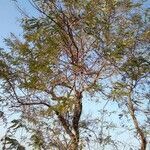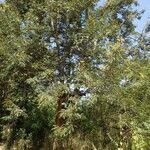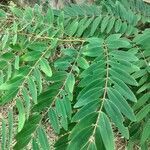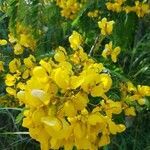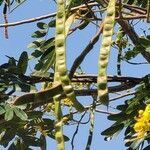Tree 5-10(-20) m tall with a rounded crown. Stipules linear, less than 1 mm wide. Leaves 15-35 cm long, the petiole 2-3 cm long, nectary absent; leaflets 5-10 pairs per leaf, elliptic, 5-8 cm long x 1.5-3 cm wide, coriaceous, apex rounded, retuse or mucronate, adaxial surface shiny and with raised reticulate venation, abaxial surface glabrous or minutely appressed-puberulent. Inflorescences of terminal clusters of corymbiform racemes, these usually leafless and forming panicles 7-20 cm long, exserted above the foliage, flowers subtended by ± persistent linear or lanceolate bracts, the peduncles and pedicels velvety-pubescent; sepals dark brown and wrinkled when dried, orbicular, velvety-pubescent; petals obovate, 1-1.5 cm long x 0.5-1.0 cm wide, glabrous; fertile stamens 7, 2 long and 5 short, basally sagittate, the apex of the filament bearing a triangular phlange dorsally, anthers dehiscent by a single terminal U-shaped pore; ovary velvety-pubescent. Pods spreading or reflexed, flattened, linear-oblong, 15-25 cm long x 1-1.5 cm wide, apically acute; valves coriaceous, velvety-pubescent, corrugate with raised reticulate veins, sutures thickened; seeds ovate, very flat, brown, areolate.
Tree to 20 m or more; bark smooth, grey. Branchlets dark brown, sparsely puberulous, somewhat ridged longitudinally. Leaves paripinnate; stipules not seen (minute, subulate according to Brenan), presumably early caducous; petiole 2-4.2 cm long, pubescent; rachis 7.5-23 cm long, pubescent; leaflets in 6-12 pairs, 2.4-6.8 x 1.1-2.9 cm, elliptic to oblong, base rounded to cuneate, apex obtuse to retuse, shortly mucronate, sparsely appressed-pubescent beneath, marginal nerve prominent; petiolules 2-3 mm long. Inflorescences terminal, paniculate; bracts 3-4 mm long, linear, pubescent, present at anthesis; pedicels 2.5-3.5 cm long at anthesis. Sepals 5, dimorphic, two c. 5 x 4 mm, three c. 10 x 8 mm, broadly ovate, glabrous to sparsely puberulous. Petals yellow, c. 12 x 10 mm, broadly obovate, claw 2 mm long. Stamens 10; seven fertile with anthers 4-5 mm long, two with filaments c. 10 mm long, five with filaments c. 5 mm long; three probably infertile with reduced anthers and short filaments. Ovary c. 5 mm long, puberulous; style 2-3 mm long, glabrous. Pod 15-23 x 0.9-1.3 cm, linear, glabrous, tardily dehiscent along both sutures. Seeds dark brown, c. 7 x 6 mm, discoid, flat.
Trees, 10-15 m tall. Bark gray, subsmooth; young branches ribbed, sparsely puberulent. Leaves 20-30 cm; stipules caducous, linear, tiny; rachis and petiole without glands, puberulent; leaflets 6-10(-15) pairs, oblong or ovate-oblong, 3-7 × 1.5-2.5 cm, leathery, abaxially finely pubescent, adaxially smooth and glabrous, base rounded, apex obtusely rounded, often emarginate, mucronate. Racemes in axils of apical leaves, often several forming a large terminal panicle on a robust peduncle 5-7 cm; bracts linear, 5-6 mm. Sepals suborbicular, unequal in size, outer smaller, inner larger, ca. 9 mm, outside hairy. Petals yellow, broadly obovate, 1.2-1.5 cm, shortly clawed. Stamens 10, among them 7 fertile, anthers opening by apical pores, 2 with filaments ca. 10 mm and anthers 6-7 mm, 4 or 5 with filaments 2-3 mm and anthers 5-6 mm, staminodes ca. 3 mm. Ovary sessile, densely white pubescent. Legume flattened, 15-30 × 1-1.5 cm, suture thick, riblike, pubescent, purplish brown when mature. Seeds 10-30, light brown, ovoid, 2-2.5 × 5-6 mm. 2n = 28.
Tree up to c. 15 m; young branches pubescent, finely striate. Stipules tiny, subulate, caducous. Leaves with 7 — 10( — 15) pairs of leaflets; petiole 2-3 cm; rachis 10-25 cm. Leaflets ovate-oblong, 3-7 by 1-2 cm; rounded or emarginate, at apex with a short mucro, rounded at base; glabrous on upper surface, finely pubescent below. Inflorescence large, terminal panicles on a robust, 5-7 cm long peduncle; bracts obovate, long acuminate, c. 5 mm; pedicels 2-3 cm, velutinous. Sepals orbicular, unequal, velutinous outside, the two outer c. 5 mm, the inner up to 9 mm. Petals yellow, oblong-obovate with a short claw, 1.5-2 cm. Stamens: 2 with filaments c. 10 mm and anthers 6-7 mm with apical dehiscence; 4-5 with filaments 2-3 mm and anthers 5-6 mm; 2-3 staminodes c. 3 mm. Ovary densely velutinous; style glabrous; stigma inconspicuous. Pods flattened, alternately expressed and depressed over the seeds giving a 'wavy' surface; sutures thick, rib-like, 20-30 by 1-1.5 cm. Seeds 20-30, ovate, light brown 20-25 by 5-6 mm.
Tree, to 30 m high, spreading, pubescent on the leaf undersides and inflorescence, soon glabrescent. Leaves (10–) 15–20 (–35) cm long including a terete petiole 25–40 mm long; stipules minute, subulate, persistent; leaflets in (4–) 6–8 (–16) pairs spaced 15–30 mm apart, oblong, 30–50 (–75) mm long, (12–) 20–30 mm wide, increasing medially or distally, emarginate and mucronulate; glands absent, replaced by transverse bars between the leaflets. Inflorescences of 10–20 (–60) flowers, in upper axils, forming a many-flowered panicle to 40 cm long; peduncles 15–25 mm long; pedicels 15–20 (–35) mm long; bracts subpersistent. Petals (10–) 15–25 mm long. Fertile stamens 7 or 10 (with 3 large staminodes); filaments unequal, the lateral abaxial ones 7–12 mm long, the others 2.5–5.5 mm long; anthers subequal, weakly beaked, 5–8 mm long, opening by one U-shaped pore. Pod flat, 15–25 (–30) cm long, 10–15 mm wide, straight but laterally curved, entire. Seeds lustrous, with a narrowly spathulate areole.
An evergreen tree. It grows to 10 m high and spreads to 4 m across. It can be a small tree or grow up to 30 m high. The stem is erect and slender. The leaves are dark green and 30 cm long. They are divided into 4-14 pairs of leaflets each 3-7.5 cm long by 1.2-2.6 cm wide. The flowers are yellow and arranged in large sprays. These can be 45 cm long. They grow at the end of branches. The fruit are black pods 35 cm long by 1.2-1.6 cm wide and bulging over the seeds. The pods have thickened edges.
Leaves paripinnate; stipules not seen (minute, subulate according to Brenan), presumably early caducous; petiole 2–4.2 cm long, pubescent; rachis 7.5–23 cm long, pubescent; leaflets in 6–12 pairs, 2.4–6.8 × 1.1–2.9 cm, elliptic to oblong, base rounded to cuneate, apex obtuse to retuse, shortly mucronate, sparsely appressed-pubescent beneath, marginal nerve prominent; petiolules 2–3 mm long.
Stamens 10; seven fertile with anthers 4–5 mm long, two with filaments c.10 mm long, five with filaments c.5 mm long; three probably infertile with reduced anthers and short filaments.
Inflorescences terminal, paniculate; bracts 3–4 mm long, linear, pubescent, present at anthesis; pedicels 2.5–3.5 cm long at anthesis.
Sepals 5, dimorphic, two c.5 × 4 mm, three c.10 × 8 mm, broadly ovate, glabrous to sparsely puberulous.
Pod 15–23 × 0.9–1.3 cm, linear, glabrous, tardily dehiscent along both sutures.
Branchlets dark brown, sparsely puberulous, somewhat ridged longitudinally.
Petals yellow, c.12 × 10 mm, broadly obovate, claw 2 mm long.
Ovary c.5 mm long, puberulous; style 2–3 mm long, glabrous.
Seeds dark brown, c.7 × 6 mm, discoid, flat.
Tree to 20 m or more; bark smooth, grey.
